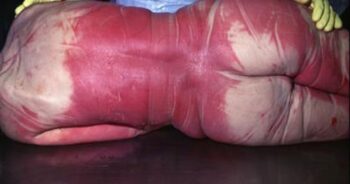Carbon Monoxide

Carbon monoxide (CO) is a colorless and odorless gas which is highly toxic to vertebrate animals, but not to non-vertebrates such as insects. CO clings more strongly than oxygen to the hemoglobin of vertebra blood, hence preventing oxygen transportation by the blood. Since the combination of CO and hemoglobin is more intensely red than the normal combination of oxygen with hemoglobin, and because CO is not consumed, and hence keeps accumulating, victims of CO poisoning are intensely pink; see the illustration.
For the average person, a CO concentration in air of some 0.4% becomes lethal within less than an hour (see the below table with more data). Healthy individuals with good cardio-vascular fitness can survive twice as long.
|
CO in %/vol. |
Physiological Effects |
|---|---|
|
(0.01) |
Permissible concentration for an exposure of several hours |
|
(0.04 – 0.05) |
Inhalation for up to 1 hour without appreciable effect |
|
(0.06 – 0.07) |
Appreciable effect after exposure of 1 hour |
|
(0.10 – 0.12) |
Indisposition but no dangerous effects after exposure of 1 hour |
|
(0.15 – 0.2) |
Dangerous concentrations for exposure of 1 hour |
|
(0.4 and more) |
Fatal in exposure of less than 1 hour |
CO develops, for instance, during the combustion of carbon-containing fuels, if there is a lack of oxygen, preventing the complete combustion (transformation) of carbon into carbon dioxide (CO2).
Pure CO in pressurized steel bottles is commercially available, and is said to have been used during the Third Reich’s euthanasia killings. Because such bottles were allegedly too difficult to transport – although they were in fact more-easily transportable than any other device to produce this gas – it was allegedly decided to use other sources of CO for poison-gas murders; see the table:
| CO Source | Device/Location |
|---|---|
|
gasoline-engine exhaust, bottled CO |
|
|
gas vans, Einsatzgruppen |
|
|
bottled CO* |
|
|
Diesel-engine exhaust |
|
|
(gasoline-)engine exhaust |
|
|
Diesel-engine exhaust |
|
| * The steel bottles found at Majdanek contained carbon dioxide, which is not toxic! | |
None of these claims are defensible; see the individual entries for more details. The following table gives an overview of existing CO sources in German-controlled areas during World War II, how easily they could have been made available, and what their possible CO-content was, meaning how lethal they were, if at all (cf. Rudolf 2024a, esp. pp. 429-434).
| CO Source | Availability | CO Content | Lethality |
|---|---|---|---|
|
bottled CO |
Commercially available, high price, easy to transport. |
100% |
extremely high |
|
process gas |
In large quantities available only near coal-liquefaction plants, such as at Auschwitz-Monowitz; requires gas-pipe hook-up. |
30-100% |
extremely to very high |
|
city gas |
Readily available in larger cities with coke processing; cheap, abundant, and with access to a large-scale infrastructure for adding and maintaining pipe networks. |
±30% |
very high |
|
From cheap fuel abundantly available (coke, coal, wood), generated in affordable producer-gas generator mounted mostly on commercial vehicles (vans, trucks, buses) and manufactured by the tens of thousands. |
15-30% |
very high |
|
|
gasoline-engine exhaust |
Readily available by the millions, although with fuel shortage. |
1-7% |
high |
|
Readily available by the hundreds of thousands, although with fuel shortage. |
0.0 to 0.4% |
Non-lethal within an hour under stationary conditions |
Looking at this table, any potential mass murderer with technical knowledge common among specialists in wartime Germany would surely have made the correct and obvious choices:
- When choosing Auschwitz as an extermination center, erect facilities near the BUNA coal-liquification plant near Monowitz. The SS already had a forced-labor camp there. A small process-gas pipe from the factory to certain camp facilities could have been laid very easily.
- For any other location, the generator-gas technology was the obvious choice.
- Diesel engines are a bad choice, as they produce sufficient CO only when driven under heavy or full load. And even then, many fit and healthy victims will survive an exposure of half an hour or more, which was the alleged maximum gassing time.
A suicide inside a gasoline car carried out in the 1970s in the U.S. by a healthy 36-year-old man, who recorded his breathing noises, showed that it takes some 20 minutes for a healthy person to die in such a scenario. This gives a rough idea of the time required to kill with gasoline-engine exhaust gases piped into the interior of a vehicle. (See Rudolf 2023, pp. 265f.; Mattogno/Kues/Graf 2015, pp. 856-868.)

You need to be a registered user, logged into your account, and your comment must comply with our Acceptable Use Policy, for your comment to get published. (Click here to log in or register.)